Abstract
OBJECTIVES: To investigate the specificity of biological monitoring variables (excretion of phenanthrene and pyrene metabolites in urine) and the usefulness of some biomarkers of effect (alkaline filter elution, 32P postlabelling assay, measurement of sister chromatid exchange) in workers exposed to polycyclic aromatic hydrocarbons (PAHs). METHODS: 29 coke oven workers and a standardised control group were investigated for frequencies of DNA single strand breakage, DNA protein cross links (alkaline filter elution assay), sister chromatid exchange, and DNA adducts (32P postlabelling assay) in lymphocytes. Phenanthrene and pyrene metabolites were measured in 24 hour urine samples. 19 different PAHs (including benzo(a)pyrene, pyrene, and phenanthrene) were measured at the workplace by personal air monitoring. The GSTT1 activity in erythrocytes and lymphocyte subpopulations in blood was also measured. RESULTS: Concentrations of phenanthrene, pyrene, and benzo(a)pyrene in air correlated well with the concentration of total PAHs in air; they could be used for comparisons of different workplaces if the emission compositions were known. The measurement of phenanthrene metabolites in urine proved to be a better biological monitoring variable than the measurement of 1-hydroxypyrene. Significantly more DNA strand breaks in lymphocytes of coke oven workers were found (alkaline filter elution assay); the DNA adduct rate was not significantly increased in workers, but correlated with exposure to PAHs in a semiquantitative manner. The number of sister chromatid exchanges was lower in coke oven workers but this was not significant; thus counting sister chromatid exchanges was not a good variable for biomonitoring of coke oven workers. Also, indications for immunotoxic influences (changes in lymphocyte subpopulations) were found. CONCLUSIONS: The measurement of phenanthrene metabolites in urine seems to be a better biological monitoring variable for exposure to PAHs than measurement of hydroxypyrene. The alkaline filter elution assay proved to be the most sensitive biomarker for genotoxic damage, whereas the postlabelling assay was the only one with some specificity for DNA alterations caused by known compounds.
Full text
PDF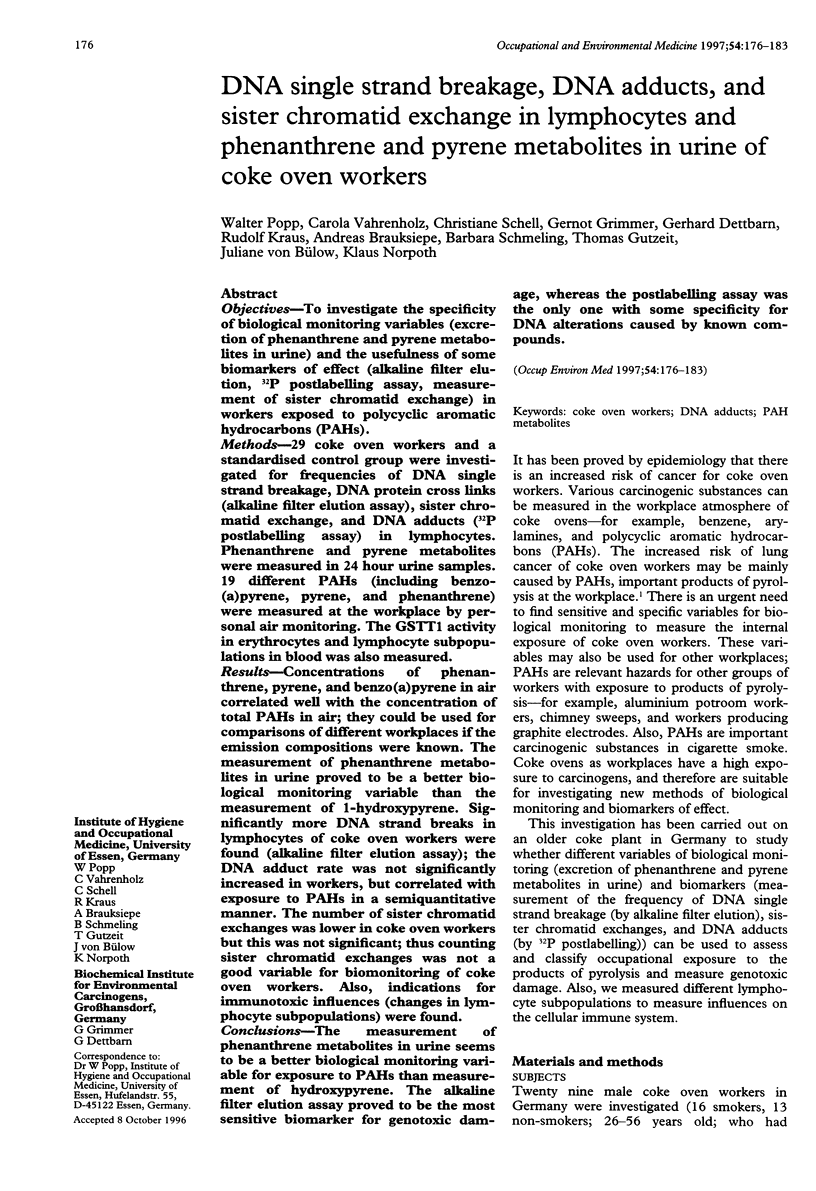
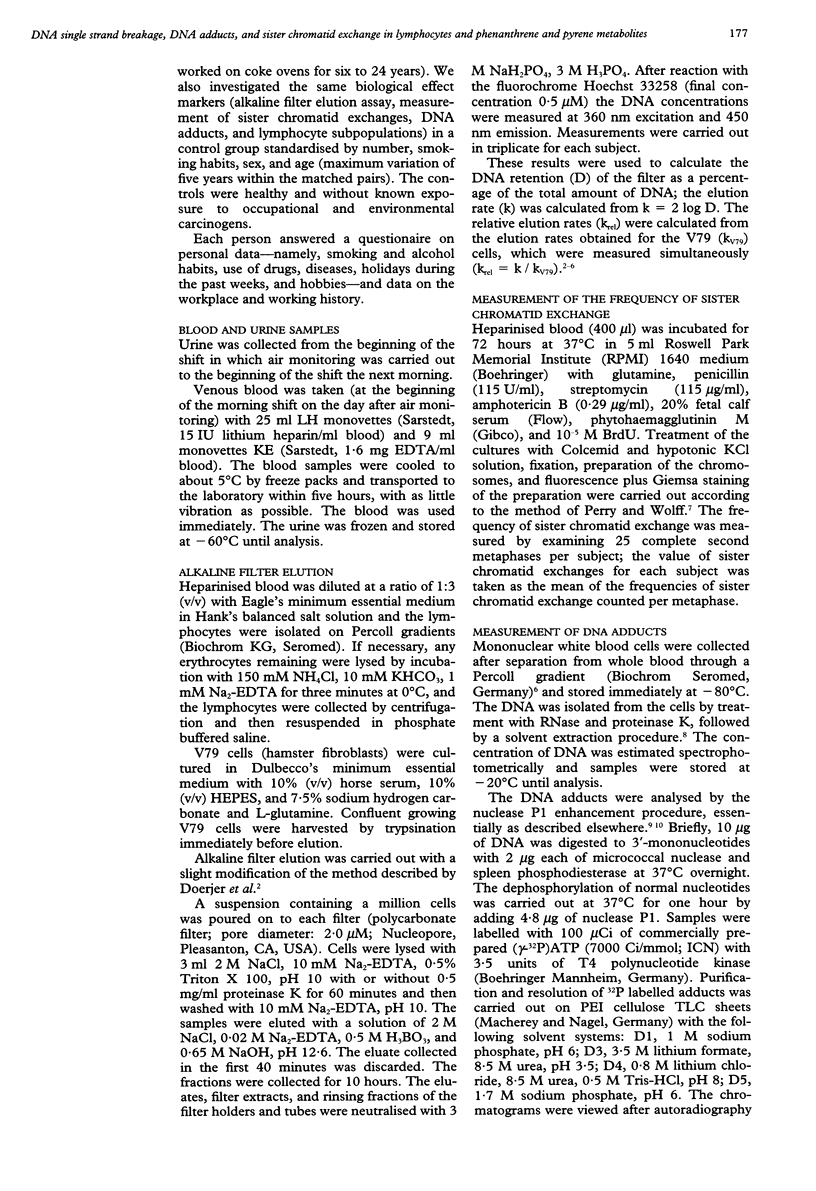
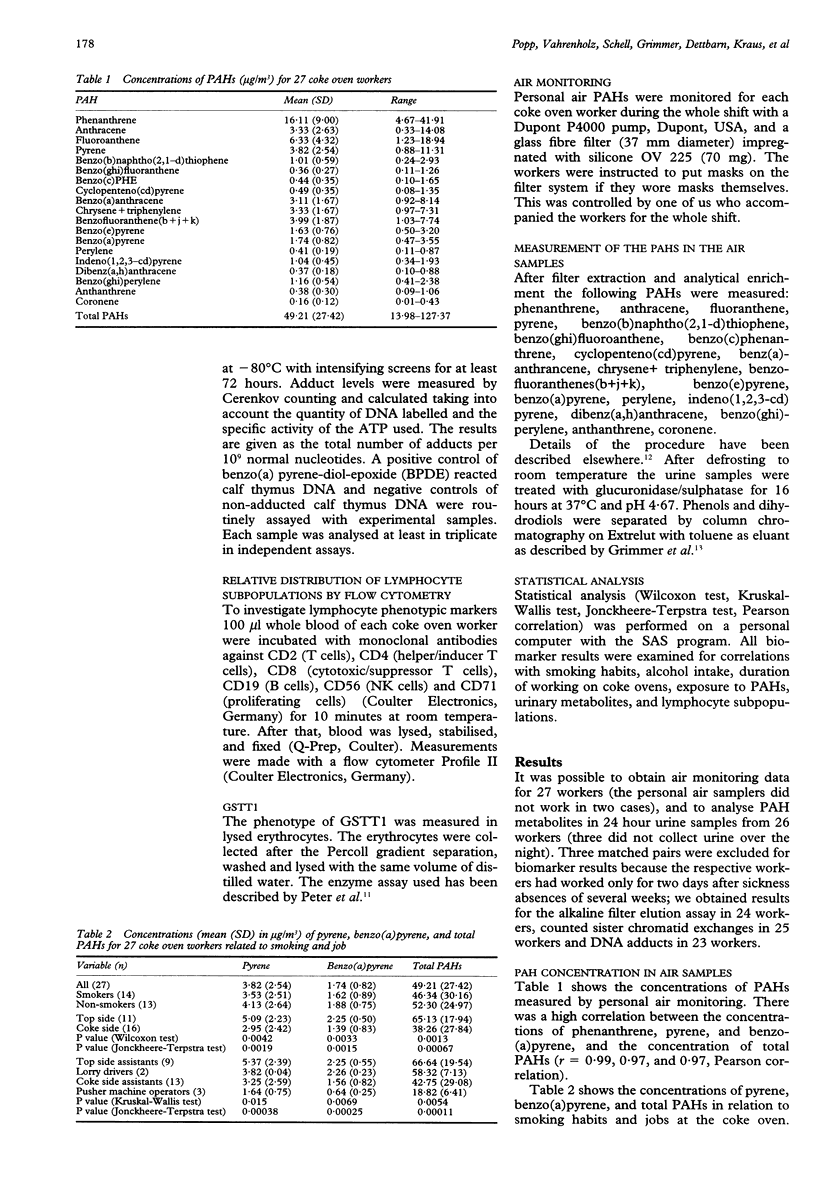
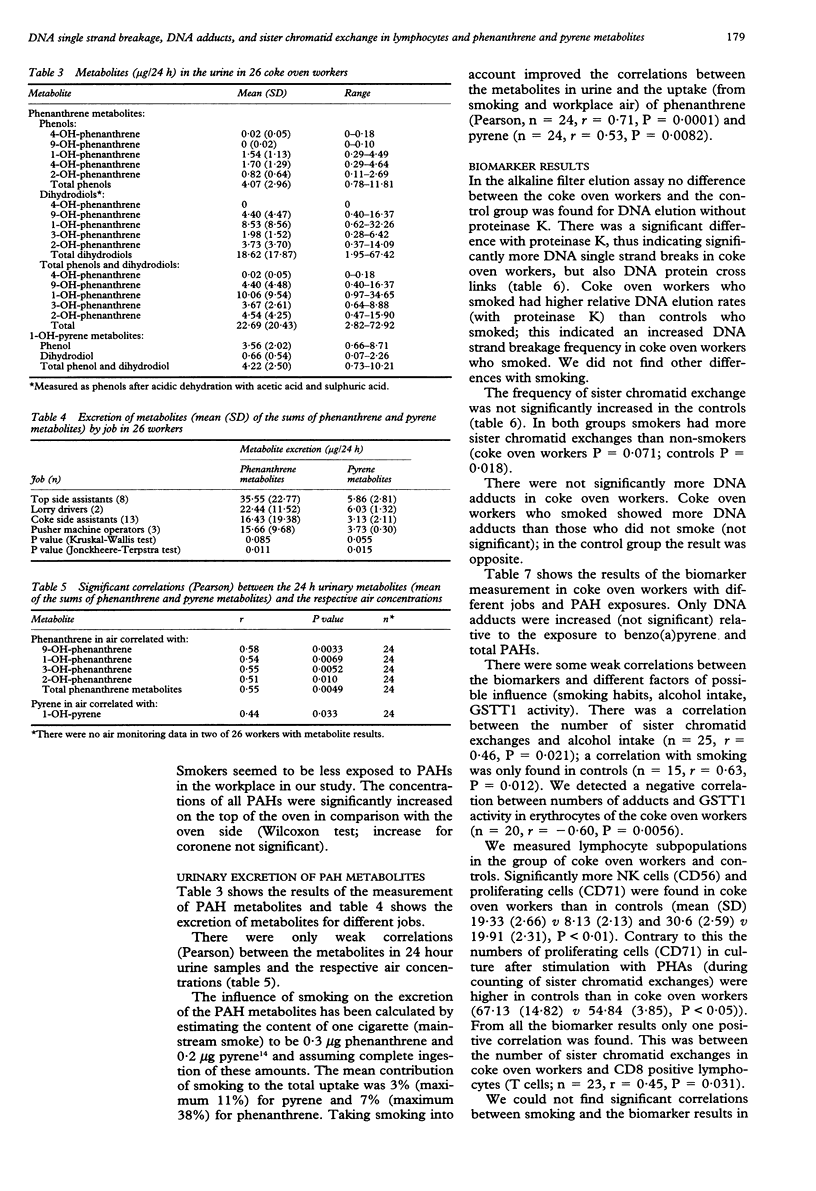
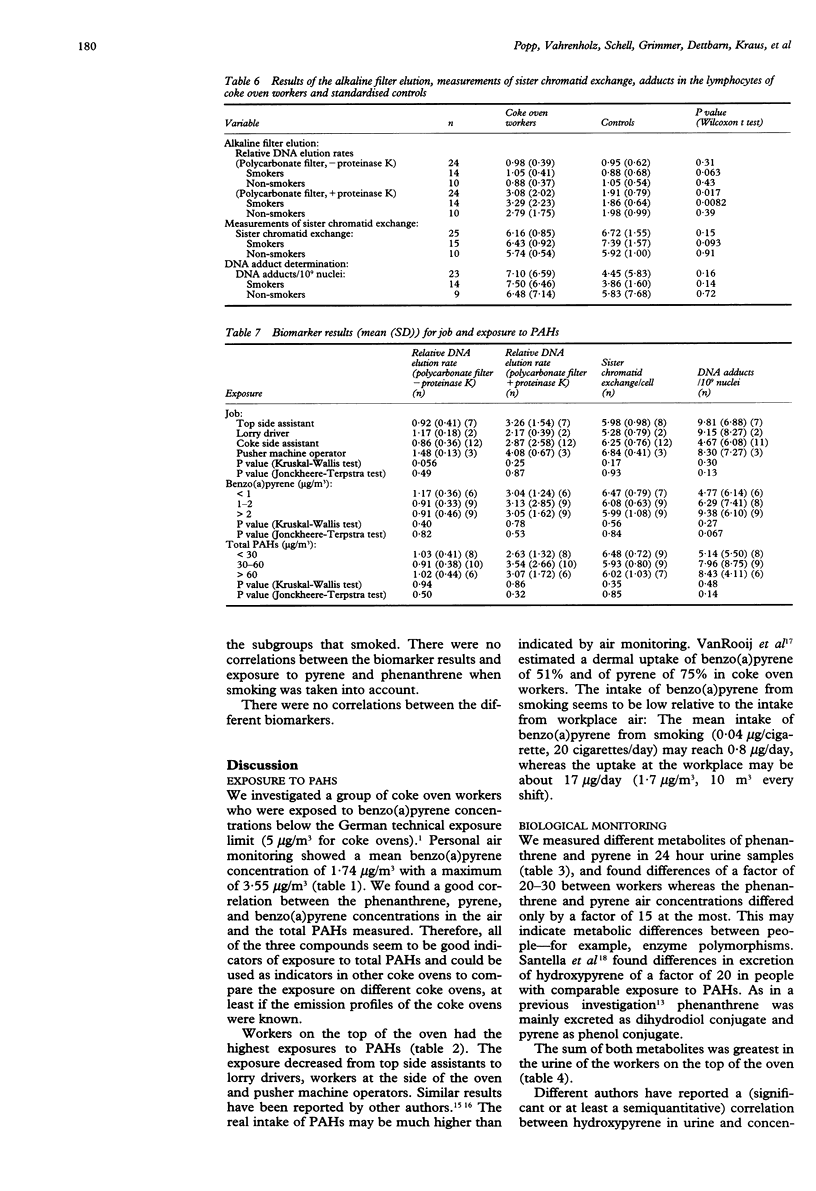


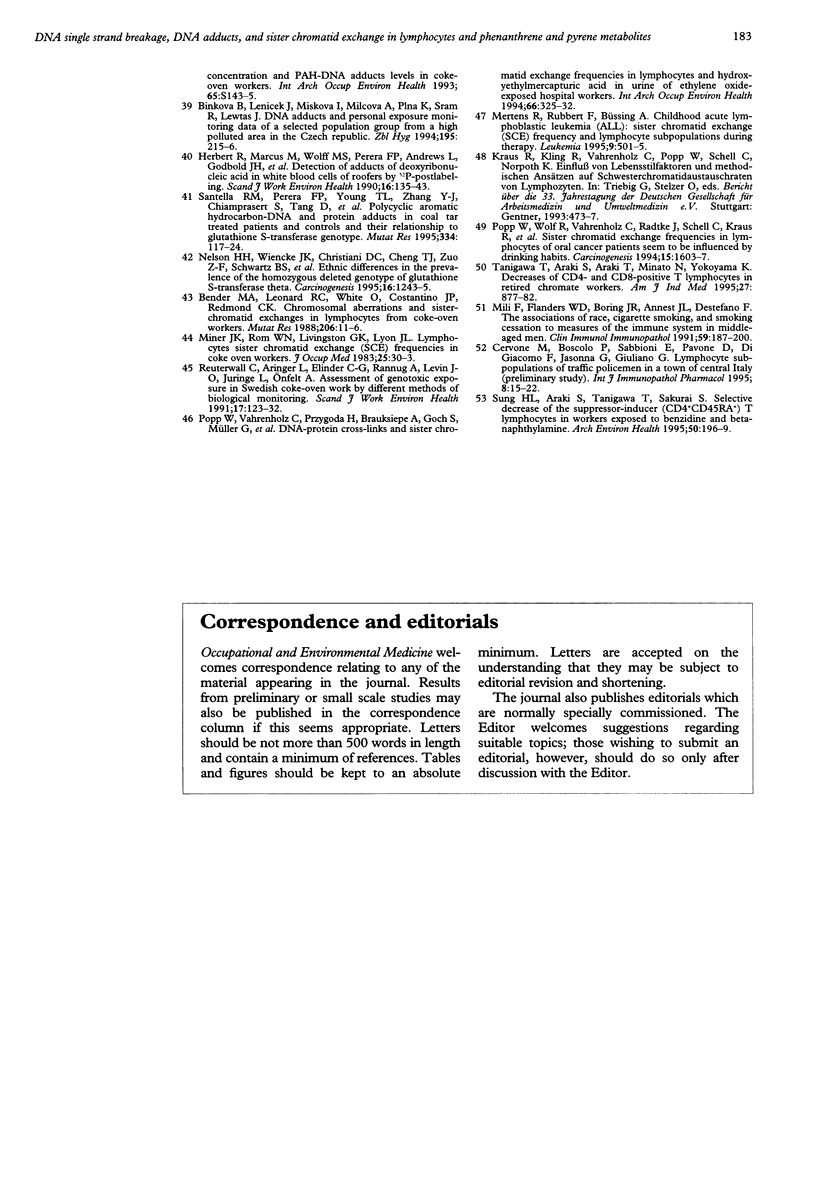
Selected References
These references are in PubMed. This may not be the complete list of references from this article.
- Assennato G., Ferri G. M., Foà V., Strickland P., Poirier M., Pozzoli L., Cottica D. Correlation between PAH airborne concentration and PAH-DNA adducts levels in coke-oven workers. Int Arch Occup Environ Health. 1993;65(1 Suppl):S143–S145. doi: 10.1007/BF00381327. [DOI] [PubMed] [Google Scholar]
- Bender M. A., Leonard R. C., White O., Jr, Costantino J. P., Redmond C. K. Chromosomal aberrations and sister-chromatid exchanges in lymphocytes from coke oven workers. Mutat Res. 1988 Sep;206(1):11–16. doi: 10.1016/0165-1218(88)90135-8. [DOI] [PubMed] [Google Scholar]
- Buchet J. P., Ferreira M., Jr, Burrion J. B., Leroy T., Kirsch-Volders M., Van Hummelen P., Jacques J., Cupers L., Delavignette J. P., Lauwerys R. Tumor markers in serum, polyamines and modified nucleosides in urine, and cytogenetic aberrations in lymphocytes of workers exposed to polycyclic aromatic hydrocarbons. Am J Ind Med. 1995 Apr;27(4):523–543. doi: 10.1002/ajim.4700270406. [DOI] [PubMed] [Google Scholar]
- Burgaz S., Borm P. J., Jongeneelen F. J. Evaluation of urinary excretion of 1-hydroxypyrene and thioethers in workers exposed to bitumen fumes. Int Arch Occup Environ Health. 1992;63(6):397–401. doi: 10.1007/BF00386935. [DOI] [PubMed] [Google Scholar]
- Cenni A., Sciarra G., Sartorelli P., Pappalardo F. Environmental and biological monitoring of polycyclic aromatic hydrocarbons (PAHs) in coke plants and other workplaces. Med Lav. 1993 Sep-Oct;84(5):379–386. [PubMed] [Google Scholar]
- Doerjer G., Buchholz U., Kreuzer K., Oesch F. Biomonitoring of DNA damage by alkaline filter elution. Int Arch Occup Environ Health. 1988;60(3):169–174. doi: 10.1007/BF00378693. [DOI] [PubMed] [Google Scholar]
- Elovaara E., Heikkilä P., Pyy L., Mutanen P., Riihimäki V. Significance of dermal and respiratory uptake in creosote workers: exposure to polycyclic aromatic hydrocarbons and urinary excretion of 1-hydroxypyrene. Occup Environ Med. 1995 Mar;52(3):196–203. doi: 10.1136/oem.52.3.196. [DOI] [PMC free article] [PubMed] [Google Scholar]
- Frenkel K. Carcinogen-mediated oxidant formation and oxidative DNA damage. Pharmacol Ther. 1992;53(1):127–166. doi: 10.1016/0163-7258(92)90047-4. [DOI] [PubMed] [Google Scholar]
- Fuchs J., Hengstler J. G., Boettler G., Oesch F. Primary DNA damage in peripheral mononuclear blood cells of workers exposed to bitumen-based products. Int Arch Occup Environ Health. 1996;68(3):141–146. doi: 10.1007/BF00381622. [DOI] [PubMed] [Google Scholar]
- Grimmer G., Dettbarn G., Jacob J. Biomonitoring of polycyclic aromatic hydrocarbons in highly exposed coke plant workers by measurement of urinary phenanthrene and pyrene metabolites (phenols and dihydrodiols). Int Arch Occup Environ Health. 1993;65(3):189–199. doi: 10.1007/BF00381155. [DOI] [PubMed] [Google Scholar]
- Herbert R., Marcus M., Wolff M. S., Perera F. P., Andrews L., Godbold J. H., Rivera M., Stefanidis M., Lu X. Q., Landrigan P. J. Detection of adducts of deoxyribonucleic acid in white blood cells of roofers by 32P-postlabeling. Relationship of adduct levels to measures of exposure to polycyclic aromatic hydrocarbons. Scand J Work Environ Health. 1990 Apr;16(2):135–143. doi: 10.5271/sjweh.1806. [DOI] [PubMed] [Google Scholar]
- Holz O., Meissner R., Einhaus M., Koops F., Warncke K., Scherer G., Adlkofer F., Baumgartner E., Rüdiger H. W. Detection of DNA single-strand breaks in lymphocytes of smokers. Int Arch Occup Environ Health. 1993;65(2):83–88. doi: 10.1007/BF00405724. [DOI] [PubMed] [Google Scholar]
- Jongeneelen F. J. Biological exposure limit for occupational exposure to coal tar pitch volatiles at cokeovens. Int Arch Occup Environ Health. 1992;63(8):511–516. doi: 10.1007/BF00386338. [DOI] [PubMed] [Google Scholar]
- Leadon S. A., Stampfer M. R., Bartley J. Production of oxidative DNA damage during the metabolic activation of benzo[a]pyrene in human mammary epithelial cells correlates with cell killing. Proc Natl Acad Sci U S A. 1988 Jun;85(12):4365–4368. doi: 10.1073/pnas.85.12.4365. [DOI] [PMC free article] [PubMed] [Google Scholar]
- Leadon S. A., Sumerel J., Minton T. A., Tischler A. Coal tar residues produce both DNA adducts and oxidative DNA damage in human mammary epithelial cells. Carcinogenesis. 1995 Dec;16(12):3021–3026. doi: 10.1093/carcin/16.12.3021. [DOI] [PubMed] [Google Scholar]
- Mertens R., Rubbert F., Büssing A. Childhood acute lymphoblastic leukemia (ALL): sister chromatid exchange (SCE) frequency and lymphocyte subpopulations during therapy. Leukemia. 1995 Mar;9(3):501–505. [PubMed] [Google Scholar]
- Miner J. K., Rom W. N., Livingston G. K., Lyon J. L. Lymphocyte sister chromatid exchange (SCE) frequencies in coke oven workers. J Occup Med. 1983 Jan;25(1):30–33. doi: 10.1097/00043764-198301000-00012. [DOI] [PubMed] [Google Scholar]
- Nakayama T., Kaneko M., Kodama M., Nagata C. Cigarette smoke induces DNA single-strand breaks in human cells. Nature. 1985 Apr 4;314(6010):462–464. doi: 10.1038/314462a0. [DOI] [PubMed] [Google Scholar]
- Nelson H. H., Wiencke J. K., Christiani D. C., Cheng T. J., Zuo Z. F., Schwartz B. S., Lee B. K., Spitz M. R., Wang M., Xu X. Ethnic differences in the prevalence of the homozygous deleted genotype of glutathione S-transferase theta. Carcinogenesis. 1995 May;16(5):1243–1245. doi: 10.1093/carcin/16.5.1243. [DOI] [PubMed] [Google Scholar]
- Perry P., Wolff S. New Giemsa method for the differential staining of sister chromatids. Nature. 1974 Sep 13;251(5471):156–158. doi: 10.1038/251156a0. [DOI] [PubMed] [Google Scholar]
- Peter H., Deutschmann S., Reichel C., Hallier E. Metabolism of methyl chloride by human erythrocytes. Arch Toxicol. 1989;63(5):351–355. doi: 10.1007/BF00303122. [DOI] [PubMed] [Google Scholar]
- Popp W., Schell C., Kraus R., Vahrenholz C., Wolf R., Radtke J., Bierwirth K., Norpoth K. DNA strand breakage and DNA adducts in lymphocytes of oral cancer patients. Carcinogenesis. 1993 Nov;14(11):2251–2256. doi: 10.1093/carcin/14.11.2251. [DOI] [PubMed] [Google Scholar]
- Popp W., Vahrenholz C., Przygoda H., Brauksiepe A., Goch S., Müller G., Schell C., Norpoth K. DNA-protein cross-links and sister chromatid exchange frequencies in lymphocytes and hydroxyethyl mercapturic acid in urine of ethylene oxide-exposed hospital workers. Int Arch Occup Environ Health. 1994;66(5):325–332. doi: 10.1007/BF00378365. [DOI] [PubMed] [Google Scholar]
- Popp W., Vahrenholz C., Schmieding W., Krewet E., Norpoth K. Investigations of the frequency of DNA strand breakage and cross-linking and of sister chromatid exchange in the lymphocytes of electric welders exposed to chromium- and nickel-containing fumes. Int Arch Occup Environ Health. 1991;63(2):115–120. doi: 10.1007/BF00379074. [DOI] [PubMed] [Google Scholar]
- Popp W., Vahrenholz C., Yaman S., Müller C., Müller G., Schmieding W., Norpoth K., Fahnert R. Investigations of the frequency of DNA strand breakage and cross-linking and of sister chromatid exchange frequency in the lymphocytes of female workers exposed to benzene and toluene. Carcinogenesis. 1992 Jan;13(1):57–61. doi: 10.1093/carcin/13.1.57. [DOI] [PubMed] [Google Scholar]
- Popp W., Wolf R., Vahrenholz C., Radtke J., Schell C., Kraus R., Brauksiepe A., Norpoth K. Sister chromatid exchange frequencies in lymphocytes of oral cancer patients seem to be influenced by drinking habits. Carcinogenesis. 1994 Aug;15(8):1603–1607. doi: 10.1093/carcin/15.8.1603. [DOI] [PubMed] [Google Scholar]
- Reddy M. V., Randerath K. 32P-analysis of DNA adducts in somatic and reproductive tissues of rats treated with the anticancer antibiotic, mitomycin C. Mutat Res. 1987 Jul;179(1):75–88. doi: 10.1016/0027-5107(87)90043-1. [DOI] [PubMed] [Google Scholar]
- Reddy M. V., Randerath K. Nuclease P1-mediated enhancement of sensitivity of 32P-postlabeling test for structurally diverse DNA adducts. Carcinogenesis. 1986 Sep;7(9):1543–1551. doi: 10.1093/carcin/7.9.1543. [DOI] [PubMed] [Google Scholar]
- Reuterwall C., Aringer L., Elinder C. G., Rannug A., Levin J. O., Juringe L., Onfelt A. Assessment of genotoxic exposure in Swedish coke-oven work by different methods of biological monitoring. Scand J Work Environ Health. 1991 Apr;17(2):123–132. doi: 10.5271/sjweh.1725. [DOI] [PubMed] [Google Scholar]
- Salagovic J., Kalina I., Dubayová K. Induction of single strand DNA breaks in workers professionally exposed to polycyclic aromatic hydrocarbons. Neoplasma. 1995;42(3):115–118. [PubMed] [Google Scholar]
- Santella R. M., Hemminki K., Tang D. L., Paik M., Ottman R., Young T. L., Savela K., Vodickova L., Dickey C., Whyatt R. Polycyclic aromatic hydrocarbon-DNA adducts in white blood cells and urinary 1-hydroxypyrene in foundry workers. Cancer Epidemiol Biomarkers Prev. 1993 Jan-Feb;2(1):59–62. [PubMed] [Google Scholar]
- Santella R. M., Perera F. P., Young T. L., Zhang Y. J., Chiamprasert S., Tang D., Wang L. W., Beachman A., Lin J. H., DeLeo V. A. Polycyclic aromatic hydrocarbon-DNA and protein adducts in coal tar treated patients and controls and their relationship to glutathione S-transferase genotype. Mutat Res. 1995 Apr;334(2):117–124. doi: 10.1016/0165-1161(95)90001-2. [DOI] [PubMed] [Google Scholar]
- Schell C., Popp W., Kraus R., Vahrenholz C., Norpoth K. 32P-postlabeling analysis of DNA adducts in different populations. Toxicol Lett. 1995 May;77(1-3):299–307. doi: 10.1016/0378-4274(95)03310-6. [DOI] [PubMed] [Google Scholar]
- Sherson D., Sigsgaard T., Overgaard E., Loft S., Poulsen H. E., Jongeneelen F. J. Interaction of smoking, uptake of polycyclic aromatic hydrocarbons, and cytochrome P450IA2 activity among foundry workers. Br J Ind Med. 1992 Mar;49(3):197–202. doi: 10.1136/oem.49.3.197. [DOI] [PMC free article] [PubMed] [Google Scholar]
- Stone K. K., Bermúdez E., Pryor W. A. Aqueous extracts of cigarette tar containing the tar free radical cause DNA nicks in mammalian cells. Environ Health Perspect. 1994 Dec;102 (Suppl 10):173–178. doi: 10.1289/ehp.94102s10173. [DOI] [PMC free article] [PubMed] [Google Scholar]
- Stout D. L., Becker F. F. Fluorometric quantitation of single-stranded DNA: a method applicable to the technique of alkaline elution. Anal Biochem. 1982 Dec;127(2):302–307. doi: 10.1016/0003-2697(82)90177-4. [DOI] [PubMed] [Google Scholar]
- Tanigawa T., Araki S., Araki T., Minato N., Yokoyama K. Decreases of CD4- and CD8-positive T lymphocytes in retired chromate workers. Am J Ind Med. 1995 Jun;27(6):877–882. doi: 10.1002/ajim.4700270611. [DOI] [PubMed] [Google Scholar]
- Van Hummelen P., Gennart J. P., Buchet J. P., Lauwerys R., Kirsch-Volders M. Biological markers in PAH exposed workers and controls. Mutat Res. 1993 Aug;300(3-4):231–239. doi: 10.1016/0165-1218(93)90055-i. [DOI] [PubMed] [Google Scholar]
- VanRooij J. G., Bodelier-Bade M. M., Jongeneelen F. J. Estimation of individual dermal and respiratory uptake of polycyclic aromatic hydrocarbons in 12 coke oven workers. Br J Ind Med. 1993 Jul;50(7):623–632. doi: 10.1136/oem.50.7.623. [DOI] [PMC free article] [PubMed] [Google Scholar]
- ng H. L., Araki S., Tanigawa T., Sakurai S. Selective decrease of the suppressor-inducer (CD4+CD45RA+) T lymphocytes in workers exposed to benzidine and beta-naphthylamine. Arch Environ Health. 1995 May-Jun;50(3):196–199. doi: 10.1080/00039896.1995.9940387. [DOI] [PubMed] [Google Scholar]
- van Schooten F. J., Jongeneelen F. J., Hillebrand M. J., van Leeuwen F. E., de Looff A. J., Dijkmans A. P., van Rooij J. G., den Engelse L., Kriek E. Polycyclic aromatic hydrocarbon-DNA adducts in white blood cell DNA and 1-hydroxypyrene in the urine from aluminum workers: relation with job category and synergistic effect of smoking. Cancer Epidemiol Biomarkers Prev. 1995 Jan-Feb;4(1):69–77. [PubMed] [Google Scholar]


